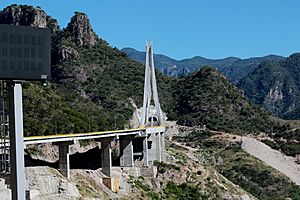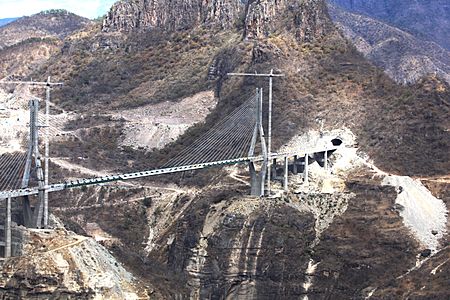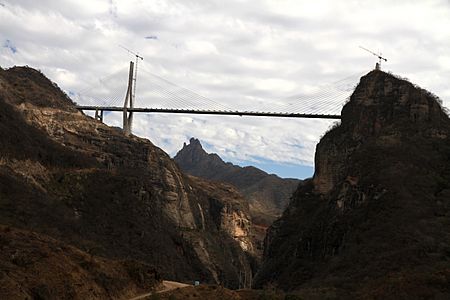Baluarte Bridge facts for kids
Quick facts for kids Baluarte BridgePuente Baluarte |
|
|---|---|

Baluarte Bridge shortly after completion,
10 March 2012 |
|
| Coordinates | 23°32′03″N 105°45′46″W / 23.53417°N 105.76278°W |
| Carries | 4 lanes of |
| Crosses | Baluarte River |
| Locale | Concordia in Sinaloa and Pueblo Nuevo in Durango, Mexico |
| Official name | Puente Baluarte Bicentenario |
| Characteristics | |
| Design | Cable-stayed bridge |
| Material | Prestressed concrete |
| Total length | 1,124 m (3,688 ft) |
| Width | 19.8 m (65 ft) |
| Longest span | 520 m (1,710 ft) |
| Clearance below | 403 m (1,322 ft) |
| History | |
| Construction begin | 21 February 2008 |
| Construction end | (inaugurated) 5 January 2012 |
| Opened | late 2013 |
The Baluarte Bridge (which means Baluarte in Spanish) is a huge cable-stayed bridge in Mexico. Its full name is the Baluarte Bicentennial Bridge. It connects the states of Sinaloa and Durango, crossing the Baluarte River. This amazing bridge is part of the Durango–Mazatlán highway.
The Baluarte Bridge is 1,124 m (3,688 ft) long, which is about the length of 11 football fields! Its main section, held up by cables, stretches 520 m (1,710 ft). The road deck is incredibly high, 403 m (1,322 ft) above the valley floor. This makes it the third-highest cable-stayed bridge in the world, the seventh-highest bridge overall, and the highest bridge in all of the Americas!
Building the bridge started in 2008. It was officially opened in January 2012 and cars began using it in late 2013. This bridge is a key part of a new highway that links the Atlantic and Pacific coasts of northern Mexico. Thanks to this new road, the travel time between Durango and Mazatlán has dropped from about 6 hours to just 2.5 hours!
How the Bridge Was Built
The Baluarte Bridge has four lanes for cars and is 20 metres (66 ft) wide. It's held up by 12 strong supports called piers. Two of these piers are also giant towers, known as pylons. The tallest pylon, called P5, stands 169 metres (554 ft) high!
Seventy-six strong steel cables stretch from these pylons. They form 152 suspenders that hold up the bridge deck. The bridge crosses a deep valley in the Sierra Madre Occidental mountains. The road deck is 390 metres (1,280 ft) above the valley floor. This is 120 metres (390 ft) higher than the famous Millau Viaduct in France!
The main part of the bridge, which is 520 metres (1,710 ft) long, is the longest cable-stayed section in North America. It's even 37 metres (121 ft) longer than the John James Audubon Bridge in Louisiana.
Building the bridge started on February 21, 2008. A group of construction companies worked together on this huge project. They chose a "cable-stayed" design because it allowed them to build outwards from the main towers. This meant they didn't need to build temporary supports, which saved a lot of time and money.
By January 2012, about 1,500 workers and engineers had helped build the bridge. They used 12,000 tonnes (12,000 long tons; 13,000 short tons) of steel and 90,000 cubic metres (3,200,000 cubic feet) of concrete. To create the bridge's foundations, they dug out 447,000 cubic metres (15,800,000 cubic feet) of rock!
The Baluarte Bridge is part of a much bigger project costing about 18 billion Mexican pesos (around US$1.44 billion). This project is building a new highway connecting Durango with Mazatlán through Mexico's very rugged mountains. The bridge itself cost about 2.18 billion pesos (around US$158.7 million).
This new highway replaces an old, challenging road through the mountains, which locals called "the Devil's Backbone." The old road was built in the 1940s, and it was so difficult to build that workers had to use mules to bring in supplies! The new highway will have 63 tunnels and 32 bridges, with eight of them being over 300 metres (980 ft) high. When finished, the new highway is expected to cut travel time between Durango and Mazatlán from eight hours to just two and a half. It's planned to be part of a future road link connecting Mexico's Atlantic and Pacific coasts. About 2,000 vehicles are expected to use the bridge every day.
Opening and Impact
President Calderón officially opened the Baluarte Bridge on January 5, 2012. Officials from Guinness World Records were there to confirm that it was the world's highest cable-stayed bridge at the time. The bridge was about 86% complete when it was opened and fully operational by 2013.
The bridge's official name, "Bicentennial," celebrates Mexico's 200th anniversary of its declaration of independence from Spain in 1810. It was hoped the bridge would open in 2010 for these celebrations, but there were some delays.
During the opening ceremony, President Calderón said the bridge would "unite the people of northern Mexico as never before." Officials hoped it would help trade and tourism in this remote part of Mexico. The new bridge and road are also expected to improve safety by making the region less isolated.
Local leaders hope the bridge will help the economy grow. The state government of Durango plans to build a new industrial park near the highway. The governor of Sinaloa expects more ships to use Mazatlán's port because of increased traffic across the country. This big project also created many jobs, with 3,500 direct jobs and another 12,000 indirect jobs.
Gallery
See also
 In Spanish: Puente Baluarte Bicentenario para niños
In Spanish: Puente Baluarte Bicentenario para niños
- List of largest cable-stayed bridges
- List of highest bridges in the world




